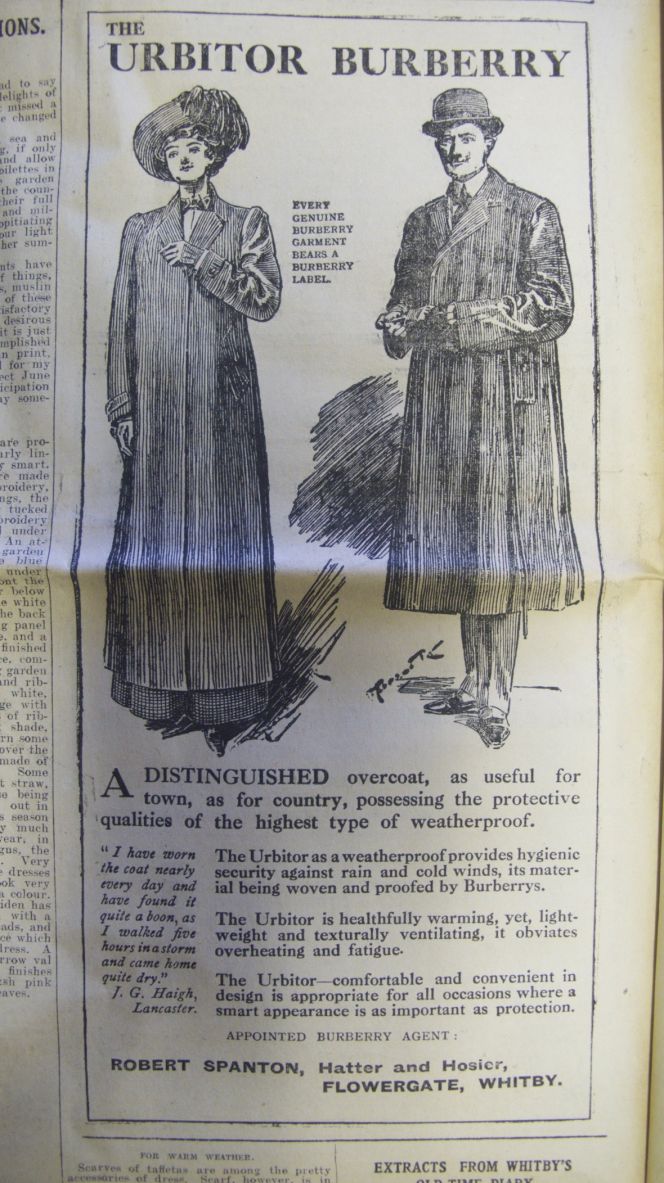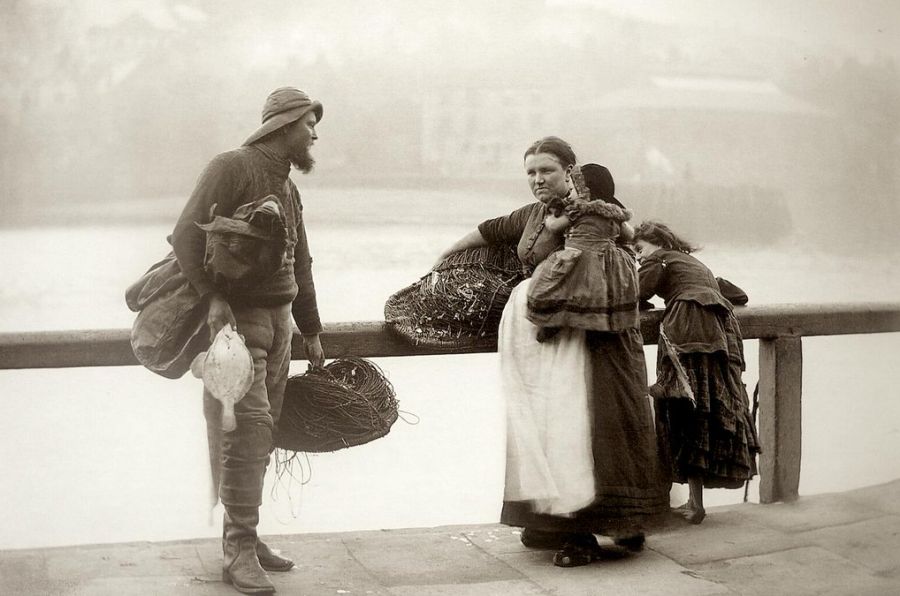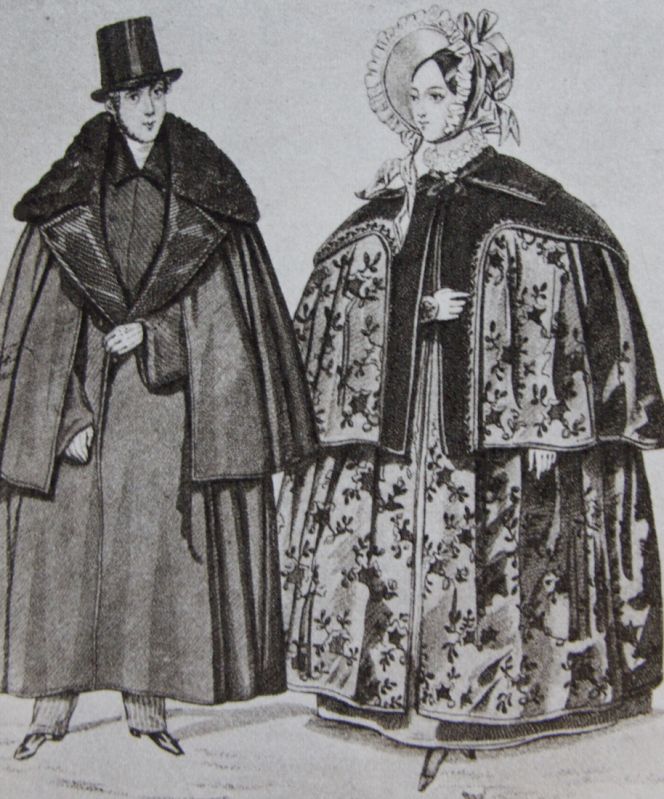ikfoundation.org
The IK Foundation
Promoting Natural & Cultural History
Since 1988


WATERPROOF GARMENTS
– The Long Nineteenth Century
It is uncertain for how long people have been making their clothes waterproof with various kinds of wax or tarpaulin, but at least in the 1700s, these methods were in common use and in the preceding century, the so-called oilskins became popular – for outdoor needs, working coats and particularly for seamen’s clothing. The Mackintosh raincoat was also invented in the 1820s with its rubberised fabric, whilst the new Garbadine fabric rapidly became popular when it was invented by Thomas Burberry in 1879. These matters have been researched from several angles in the monograph The Textile History of Whitby 1700-1914, which will be exemplified and added with a few facts based on sources giving further proof for the protection of outdoor clothing.
 Waterproof coats of Garbadine fabric and the so-called Urbitor which was lightweight as well as weatherproof were popular materials for outdoor garments in the early 20th century. The Hatter & Hosier Robert Spanton on Flowergate of Whitby advertised Burberry’s waterproof coats in the local Whitby Gazette, in this notice from 1912 he also stated that the firm by now was an ‘Appointed Burberry Agent’. (Whitby Museum, The Library). Photo: Viveka Hansen.
Waterproof coats of Garbadine fabric and the so-called Urbitor which was lightweight as well as weatherproof were popular materials for outdoor garments in the early 20th century. The Hatter & Hosier Robert Spanton on Flowergate of Whitby advertised Burberry’s waterproof coats in the local Whitby Gazette, in this notice from 1912 he also stated that the firm by now was an ‘Appointed Burberry Agent’. (Whitby Museum, The Library). Photo: Viveka Hansen.An early historical source for weather protection of sails in Whitby was included in William Scoresby the Younger’s notebooks for 1821 and 1822. Both books reinforced necessary equipment for the ‘Sailmaker’ who needed to bring ‘Canvas, Tarpaulin, Whipping, Sewing thread’ with him in various quantities for the Arctic whaling trip. Presumably, the tarpaulin was not only in use for the sailmaker's needs; sailors must themselves have been able to apply tar to their clothes and also to restore the waterproofing when it wore off.
More than seven decades later, there is instead proof for the possibility to buy Mackintosh coats in Whitby. James N. Clarkson & Son at 19 Bridge Street sold, according to this announcement in Whitby Gazette on 17 May 1895, among various clothes and textile furnishing: ‘Mackintoshes and Imperial Cloaks – A complete and useful variety, both in style and material.’
 It is hard to get a glimpse of the oilskins worn by the fishing community in Whitby on the numerous photographs by Frank Meadow Sutcliffe, but this family portrait in 1889 is a rare example showing the oilskin jacket under the fisherman’s arm. (Photo: Frank Meadow Sutcliffe).
It is hard to get a glimpse of the oilskins worn by the fishing community in Whitby on the numerous photographs by Frank Meadow Sutcliffe, but this family portrait in 1889 is a rare example showing the oilskin jacket under the fisherman’s arm. (Photo: Frank Meadow Sutcliffe).Wind- and waterproof garments like a woollen knitted gansey were often made very tight fitting as if to provide the body with an extra skin. The sleeves would be relatively short so that the cuffs would not be in constant contact with cold water, though during particularly cold or wet weather, oilskins would also be worn over these knitted sweaters. Oxford Dictionary lists the following about “oilskin” ‘heavy cotton cloth waterproofed with oil – a fisherman’s outfit of yellow oilskin.’
This type of outer garment also appears in a local advert in Newton’s Guidebook for Whitby, printed in 1903. The hosiery R. Jackson & Son of Bridge Street now advertised everything that a gentleman could possibly need, drawing particular attention to ‘Gentlemen’s Umbrellas, Waterproof Coats, and Oilskin Clothing of every description’.
 It may also be noted that without receiving waterproof treatment, the long-lasting fashion of wearing large capes or cloaks – if one could afford to buy such a large amount of cloth for a single garment – was of course weather protecting in themselves. This fashion plate of 1834 from “Theaterzeitung” shows very clearly the large quantity of cloth needed to make a full-length cape. However, few outer garments of this type have been preserved, since the fabric was ideal for re-use to make children’s clothes and the like once the original was out of fashion. (Fashion Magazine “Theaterzeitung” 1834).
It may also be noted that without receiving waterproof treatment, the long-lasting fashion of wearing large capes or cloaks – if one could afford to buy such a large amount of cloth for a single garment – was of course weather protecting in themselves. This fashion plate of 1834 from “Theaterzeitung” shows very clearly the large quantity of cloth needed to make a full-length cape. However, few outer garments of this type have been preserved, since the fabric was ideal for re-use to make children’s clothes and the like once the original was out of fashion. (Fashion Magazine “Theaterzeitung” 1834).The advertisements in Whitby Gazette also give further evidence for water-protective clothes. Among others, in November 1876, the family hosiers, glovers and shirt makers Greensmith & Thackeray at no. 12 St Ann’s Staith, Whitby advertised for a wide range of winter clothing, including waterproof and ulster coats as necessary items.
The Edmund Crane & Co drapery in Bridge Street noted, for example, instead in the spring of 1909: ‘Notice, Important to the Public, We don’t close our Establishment on Whit-Monday. Instead, we intend making a Special Show of New Spring Goods.’ The announcement concerned fabrics for sewing into clothes; alternatively, if the customer preferred, clothes could be made up by a tailor or dressmaker, or ready-made in the form of ‘Smart Tweed Coats, Waterproof Coats, Cream Costumes, Dress Skirts, Belts, Ostrich Feathers, Lace Ties, Corsets to every figure and every price…’ In other words, clothes typical of Edwardian ladies’ fashions, together with the popular waterproof garments that had begun being worn more widely in the 1880s and 1890s. A final example comes from 18 April 1889 as Skelton and Jefferson of Hinderwell, sold among other jackets etc ‘The New “Princess” Waterproof Cloak.’
Sources:
- Hansen, Viveka, The Textile History of Whitby 1700-1914 – A lively coastal town between the North Sea and North York Moors, London & Whitby 2015 (Chapter III & pp. 175-78).
- Whitby Gazette, 1855-1914 (Whitby Museum, Library & Archive).
- Wikipedia (Search words: ‘Garbadine’ & ‘Mackintosh’).
More in Books & Art:
Essays
The iTEXTILIS is a division of The IK Workshop Society – a global and unique forum for all those interested in Natural & Cultural History from a textile Perspective.
Open Access essays, licensed under Creative Commons and freely accessible, by Textile historian Viveka Hansen, aim to integrate her current research, printed monographs, and earlier projects dating back to the late 1980s. Some essays feature rare archive material originally published in other languages, now available in English for the first time, revealing aspects of history that were previously little known outside northern European countries. Her work also explores various topics, including the textile trade, material culture, cloth manufacturing, fashion, natural dyeing, and the intriguing world of early travelling naturalists – such as the "Linnaean network" – viewed through a global historical lens.
For regular updates and to fully utilise iTEXTILIS' features, we recommend subscribing to our newsletter, iMESSENGER.
been copied to your clipboard




– a truly European organisation since 1988
Legal issues | Forget me | and much more...
You are welcome to use the information and knowledge from
The IK Workshop Society, as long as you follow a few simple rules.
LEARN MORE & I AGREE







